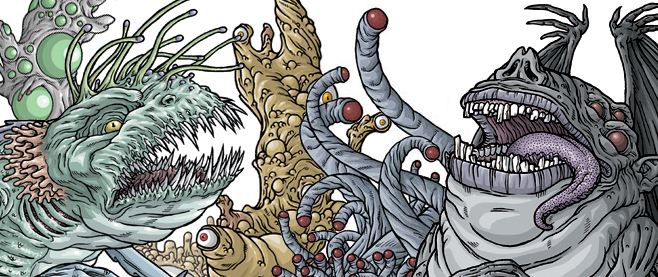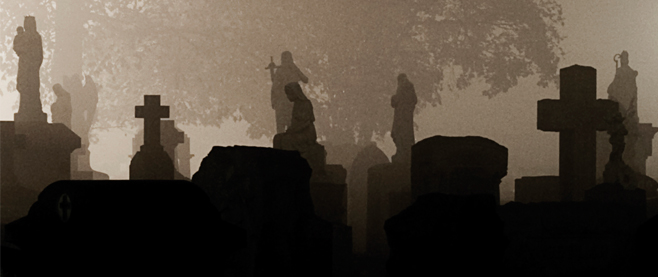Miskatonic Theatre

When one thinks of the worlds of H.P. Lovecraft, especially one who is already familiar with his works, downtown Manhattan isn’t the first thing that springs to mind. Generally the 20th Century’s master of the weird tale causes people to think of long dead underwater cities, reeking chthonic tunnels and dark clusters of ancient forests. But, if you’re in the city, and are an intrepid investigator, you’ll have head down to Manhattan’s East Village. There you’ll mount the cracked and pitted stone stairs outside of 85 East 4th Street. Once inside you’ll sidle up to a ticket-booth, a glass partition separating you from the bespectacled man within, lit by a yellowish light. The man in the booth will either sell you a ticket, or check your name off of a list. Once you’ve got your ticket, you’ll walk through a dim entryway lined with dark and dirty velvet curtains. Once through, another gentleman will take your ticket from you and without a word point you toward a small flight of black wooden steps. Those steps will lead you to a dark pit, a small recessed stage area. Dark, creaky, dusty; there are sloping tiers of seats, a number of them occupied by other seekers of the strange, but many others are empty, lifeless.
Ahead, on the backdrop of a black stage, hangs a colorful portrait of the man himself – H.P. Lovecraft. It is here, at the Kraine Theatre, that Radio Theatre NYC performed the H.P. Lovecraft Festival, which ran from March 17th to April 3rd. The festival is a radio-style dramatization of a selection of Lovecraft’s tales, complete with a quartet of actors performing different parts to music, sound effects and lights.
Okay, the Kraine Theatre may not be as dingy and ominous as I described above, but it is located right below the soviet-themed KGB bar (once a Ukranian speakeasy), so it’s got the weight of history behind it. Radio Theatre NYC covered a variety of Lovecraft’s tales during their run, splitting them into two programs. Program A featured: Dagon, From Beyond, The Beast in the Cave and Pickman’s Model. Program B featured: The Dunwich Horror and The Music of Erich Zann.

I guess now would be a good time to mention that I’m pretty much as big a Lovecraft nerd as they come (I often refer to myself as a Cthuligan in polite company), so I’m pretty familiar with the specifics of each story dramatized. I won’t however, be too nitpicky, because I completely understand that in order for something that works in one medium to work in another, there must be changes. None of them were too egregious, which is good. The show started with a Lovecraft-like narrator, played by Alfred Gingold, reading a passage from Nyarlathotep, which was a great way to get us in the mood for the weird styling we were there to experience.
The first actual story up was Pickman’s Model, often one of the first Lovecraft stories people run across, probably due to its formulaic nature. For those who’ve never read these stories, I may as well give a one sentence synopsis of each.
In Pickman’s Model a gifted painter shocks the art world with surprisingly realistic portraits of monsters, but where does he get his inspiration?
The Radio Theatre crew did an admirable job of adapting it. The performances by Jeff Essex, who portrayed the narrator, and Peter Reznikoff, who played Pickman, were good. Both actors had great range, great passion in their voices and delivered some—it has to be said—strange dialogue without skipping a beat. It was sometimes distracting watching the actors emote on-stage, given their range of motion was limited to a stool, so most of their “acting,” especially is Essex’s case, was done with their hands. I don’t know that they can be faulted for this, though, and I didn’t notice it in any of the other adaptations. The music and audio effects in the scene where Pickman brings the narrator to his underground painting studio were very effective, and did a great job of fleshing out the scene as well as creeping me out.

The second story was From Beyond. In this tale a scientist discovers a way to extend the senses of mankind beyond their usual scope, but what things lurk in those spaces?
The two characters in this one were Natalie Martin, playing Mrs. Tillinghast, and Alfred Gingold, who played the mad scientist, Crawford Tillinghast. This one was far and away my favorite, which is strange because it was the one I was looking forward to the least. From Beyond is not my favorite Lovecraft story. Both Martin and Gingold were compelling, and the visual and audio effects that the Director/Producer/Everything Else, Dan Bianchi, used to simulate the extended perception of the actors was lo-fi brilliant.
The third tale was The Beast in the Cave, another one that, in story form, is a bit too formulaic for my taste. The Beast in the Cave tells of a tourist is lost in a cave, but what beast is also in that cave?
This dramatization was also really good. It featured Alfred Gingold as the tourist, and much later on, Peter Reznikoff as a tour guide. Gingold played this one with a lot of humor, which I really appreciated because the story is pretty transparent—you can see the twist coming a mile away—so it gave me something else to enjoy as things played out. Also, Lovecraft himself was a bit of a humorist, albeit an erudite one (see Ibid, and some would say The Reanimator and The Unnamable), so it was nice to see a lighter take on one of his stories.

The final tale was Dagon, and I was really looking forward to this one. In Dagon a sailor finds himself stranded on a strange landmass, and what he witness there drives him mad!
This story is one of my favorites. It’s filled with strange imagery, bizarre atmosphere and some pretty great writing as far as weird tales go. The dramatization, however, suffered from the attempt to make it more into a narrative than just a weird, atmospheric piece.
The stories in Program B were also very well done. The Music of Erich Zann was the first tale up. In this tale a student rents a room in an old boarding house and hears the weird music of his upstairs neighbor coming through the floor, but flees upon finding out why the music is so weird, and can never find the boarding house again!
For some reason they changed the instrument Zann plays from a viola to a piano, but in the long run it didn’t make much of a difference. This adaptation of Zann really captured the weird essence of Lovecraft as a seemingly insane man playing strange notes out of a piano in response to something outside his garret window. Jeff Essex once again played the driven-mad narrator (as in Pickman’s Model), and his vocal range and use of the microphone to denote narration from dialogue was both subtle and very effective. Peter Reznikoff played Zann, and it sometimes felt as if he was getting lost in the stutters and stumbles of the frailty of the old musician.

The Dunnwich Horror was, of course, the marquee name for Program B. I was crazy interested to see how Radio Theatre NYC would adapt Lovecraft’s tale of backwoods incest, black magick and divine invasion. Surprisingly, they adopted a very conversational, outright oral story-telling tone for this, which fit the story quite well. The basic narration was handled by Jeff Essex and Natalie Martin–playing unnamed Dunwich folk– with Peter Reznikoff joining in as the snoopy neighbor, and later as Wilbur Whateley. Alfred Gingold ably joined halfway into the story as Miskatonic University Professor Armitage. I’ve read this story countless times, I pretty much know the entire story structure back and forth, and yet the production kept me enthralled and smiling (though that’s perhaps not the “right” reaction to a horror story, but I am a Cthuligan, after all). I suppose in an attempt to make the tale a little more relatable to New Yorkers they changed the whippoorwills to pigeons – not a huge change and it had a good payoff at the ending. The crescendo of the story, where the group of professors faced the actual Horror, was spectacular, and again Bianchi’s lo-fi brilliance created a vivid scene where there are only lights, shadows and voices. My only gripe was with Reznikoff, who sometimes seemed to stumble his way around the script, although I probably shouldn’t fault someone who can’t deliver something like “Eh-ya-ya-ya-yahaah—e’yayayayaaaa . . . ngh’aaaaa . . . ngh’aaaa . . . h’yuh . . . h’yuh . . . HELP! HELP! . . . ff—ff—ff—FATHER! FATHER! YOG-SOTHOTH! . . .” in a believable manner.
All in all the Lovecraft Radio Festival was an entertaining and unique take on the work of H.P. Lovecraft. I went with both hardcore fans and someone who was totally unfamiliar and both had a great time. Fun for cultists and virgins alike!




